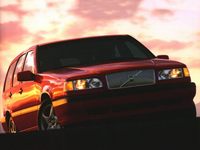New Car Review
SEE ALSO: Volvo Buyer's Guide
1996 Volvo 855 Station Wagon T-5
by JOHN HEILIG
SPECIFICATIONS
ENGINE: 2.3-liter DOHC turbocharged inline five cylinder
HORSEPOWER/TORQUE: 222 hp @5200 rpm/221 lb.ft. @ 2100 rpm
TRANSMISSION: Four speed automatic
FUEL ECONOMY: 19 mpg city, 26 mpg highway, 20.3 mpg test
WHEELBASE: 104.9 in.
OVERALL LENGTH: 185.4 in.
OVERALL WIDTH: 69.3 in.
OVERALL HEIGHT: 56.9 in.
CURB WEIGHT: 3,287
FUEL CAPACITY: 19.3 gal.
LUGGAGE CAPACITY: 37.1/67.0 cu. ft. (rear seats up/down)
TIRES: 205/50ZR16
INSTRUMENTS: Speedometer, tachometer, fuel level,
water temperature, fuel management computer, digital clock.
EQUIPMENT: AM/FM stereo with cassette and in-dash CD, power seats,
power moon roof, cruise control, leather seats,
power mirrors, power windows, four air bags, ABS.
STICKER PRICE: $33,630
Volvo is the station wagon king of America. Sure, there is probably data to prove that some other manufacturer produces and sells more wagons, but in my area of the world it seems that every other wagon on the road is a Volvo of some type or era.
The latest is the 855, with a 190 horsepower 2.4-liter turbocharged five-cylinder engine, electronically controlled four-speed automatic transmission and incredible luxury and comfort. It also has a price tag of $33,630, which I thought was high initially, but on later examination I realized it was relatively low for a Volvo, especially one with all this car has to offer.
What impressed me most about the 855 was its smoothness. In a week that saw us put almost 1,000 miles on the car, we were never tired of driving it, nor were we ever suffering from aches and pains when we exited. The leather upholstered seats were incredibly comfortable, and had a multitude of adjustments to increase that comfort. The driver's seat was powered, but the passenger had to work a few knobs and levers to get the most out of that seat.
In the rear was a bench that could honestly seat three passengers. If you have cargo to carry instead of passengers, fold down the back of that seat for a flat-floor cargo area that is a good size. I'm not sure if you could carry a 4x8 piece of plywood, but we did carry all the lights and props for a small stage production.
I particularly liked the handling of the 855 wagon. Constant readers will not that I take a winding road to work every morning. The Volvo handled all the curves easily, and seemed to ask to be driven hard. What was nice about it, of course, was that a Volvo wagon is essentially "invisible" and doesn't attract attention no matter what the speed.
Front suspension is independent by MacPherson struts and coil springs. In the rear is a semi-independent suspension that Volvo calls "delta link steer link." This features separate coil springs and shock absorbers on lower control arms made of aluminum alloy. These control arms are attached to the car's underbody via separate, short links called "Delta" links.
The Volvo was smooth on the highway as well. With the turbocharged 2.4-liter engine, acceleration was very good on entering Interstates, and we could keep up with anything else on the road. It was important to keep an eye on the speedometer, though, to be certain that we didn't get too exuberant. But the 855 could cruise at illegal speeds all day.
One feature I didn't like was the remote keyless entry, although I must admit that part of the problem was my own. There are two unlabeled buttons on the key fob; the larger is to lock the doors and the smaller is to unlock them. Two pushes on the "unlock" button unlocks all the doors. But I guess my problem was with the lack of marking. An owner will make the same mistake once and remember. But we drive a lot of cars, and repeat our mistakes. Pushing the lock button at the wrong time can set off the alarm system.
Another minor complaint was with the passenger seat belt. When it wasn't being used it didn't retract fully into the reel. Therefore, the buckle hung loose and rattled against the side of the car. In some cars you won't notice this slight noise, but the Volvo rode quietly and every noise was noticeable.
We actually drive two Volvo wagons, a T and a GLT. The latter carried a sticker price of $37,975 and had many more luxurious features, such as a beautiful leather seat, among the options. The engine in this car was rated at 222 hp, but the difference between the two cars wasn't that great. Both offered great acceleration and smooth top-end running.
Volvos are, of course, safe. Besides a warning on the Monronie sticker to "Drive Safely," the 855 Wagon has dual air bags in the dash and a side impact protection system that includes side-mounted air bags as well. In addition the comfortable seats also are safe, with decent headrests (protection against whiplash claims in rear-end collisions) and comfortable seat belts. So many people claim that they don't use their seat belts because they're uncomfortable. Can't use that excuse in the Volvo.



